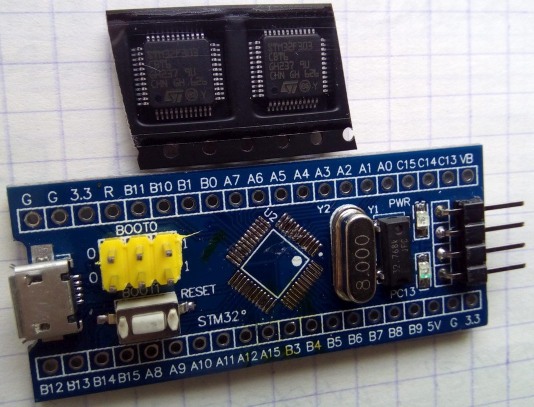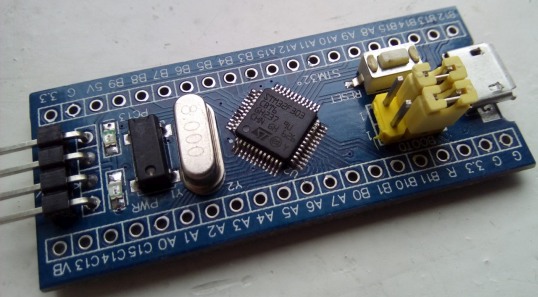Miniscope v2d
Cheap low-speed dual channel PC/USB oscilloscope and arbitrary waveform generator with STM32F3 microcontroller.
Miniscope v2d is based on STM32F303CBT6 microcontroller - LQFP48 device from STM32F3 family featuring:- 32 kB RAM on data bus
- 8 kB RAM on instruction bus
- 128 kB FLASH memory
- USB device (full speed)
- 4 fast and flexible ADCs
- 12-bit DAC with two output channels
- 4 opamps that can work in PGA mode
- ROM bootloader with USB DFU option available
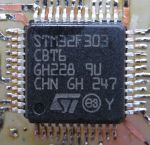
STM32F303CBT6 is pin compatible with STM32F103C8T6 used in miniscope v2c and
previously designed PCB could be reused. Still few changes were made to make better
use of STM32F303. USB pull-up resistor can now be controlled by software and is
also disconnected when device is in reset state to allow re-enumeration without
physical disconnecting and more convenient switching between bootloader and
user firmware (DFU is intended to be used to upload firmware).
As a side note: it looks like DFU is not working on similar STM32F37x microcontrollers (ebrombaugh.studionebula.com).
STM32F30x ADCs are significantly faster than in STM32F1 (7.2 MSPS in 8-bit mode), but practical sampling speed is limited because of lack of input buffer. Of course PGA would help with getting optimal combination of speed/precision, sensitivity and acceptable input impedance.
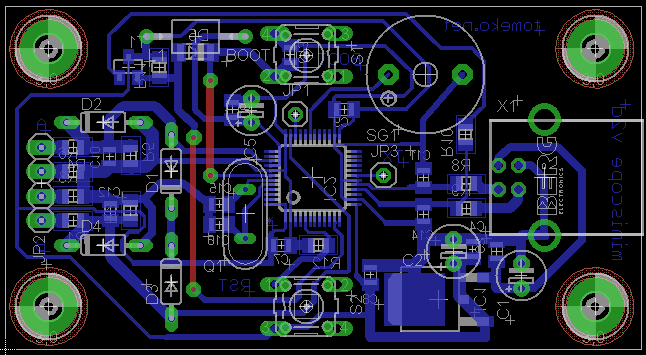
IDE
Since STM32F303 is still (2013.04) not officially supported by CoIDE (that was used with miniscope v2c) and latest CoIDE versions are getting enormous (1.8 GB installed) I've switched to plain Eclipse for C/C++ (Juno SR2), gcc (gcc-arm-none-eabi-4_7-2013q1-20130313-win32.zip) and build tools from MSYS for initial development and later to Keil (free version with 32 kB code limitation).
Project files
Note: using this hardware directly is not recommended - chosen analog channels set does not allow to use integrated PGA of STM32F3 (routing of opamps inputs is limited).
Schematic: miniscope_v2d.pdf
Eagle files: miniscope_v2d_20130413.zip
PCB photo:
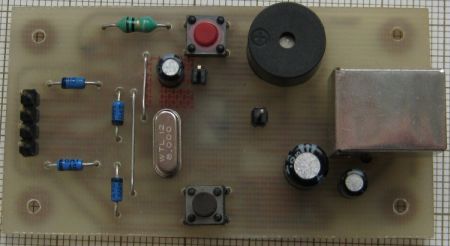
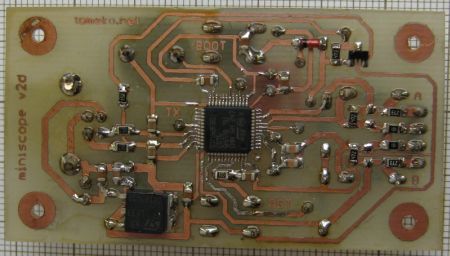
Firmware can be also used without any changes (not even recompiling) with STM32F3DISCOVERY (thanks to Aldo for testing and reporting).
Firmware
Initial board test ("LED blink" using buzzer), Eclipse + gcc: STM32F3_test_20130505.7z.
Oscilloscope firmware, Keil: miniscope_v2d.7z and dll library: miniscope_v2d_dll_1ch.7z. This firmware is limited to single channel mode sampling and streaming data continuously at 750 kSps speed - mostly it doesn't make use of STM32F3 over STM32F1 improvements. Unless you would like to built upon or already have STM32F3DISCOVERY or similar board miniscope v2c might be currently better choice.
2013.06.09: 2-channel version (2 x 428.6kSps).
miniscope_v2d_2ch_20130609.7z
miniscope_v2d_dll_2ch_20130609.7z
2013.06.15: Changed input divider to 27k + 22k and updated sensitivity in device library. Added arbitrary waveform generator function:
- works simultaneously with oscilloscope function,
- 8 bits per sample,
- output voltage: 200 mV to 3100 mV with output buffer enabled, 0 V to 3.3 V if output buffer is disabled (at the cost of high impedance load required),
- required load resistance for 1LSB error in 12-bit mode with output buffer enabled: 5kOhm; for 8-bit mode limiting factor would be nominal buffer output capability, 0.5mA,
- wave shape memory: 8192 samples,
- practical DAC feeding speed limit: hundreds kHz (datasheet specifies 1 MHz for 1-bit changes) - example traces,
- defining shape by hand drawing,
- JSON export/import; waveform may be created i.e. with spreadsheet.
Firmware: miniscope_v2d_AWF_20130615.7z
Dll for miniscope v4: miniscope_AWF_dll_20130615.7z
Updated dll: miniscope_v2d_AWF_dll_20140103.7z
(added standard shapes generator - sinus, square, triangle, sawtooth, noise,
added text status to drawing window giving information of current cursor position).

Although windows driver (libusb-win32) is included in dll archive using Zadig is actually easier and
it is only sensible option for 64-bit Win8/Win10:
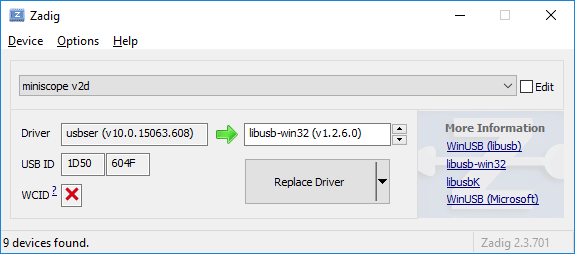
Generator demonstration - channel A connected to own DAC output, channel B connected to 51 Hz square wave for reference:
Complementary tools
bin2dfu
While STM DFU file manager tool does the job, running it with every build gets tedious. Since DFU(Se) file format is described in STM's UM0391 note and also DFU file manager comes with source code writing its replacement is not difficult. Bin2dfu is a command line utility allowing to create dfu file from bin file by adding appropriate rule to makefile:
$(PROJ_NAME).dfu: $(PROJ_NAME).bin
@tools/bin2dfu --i $(PROJ_NAME).bin --a 0x08000000 --o $(PROJ_NAME).dfu
Parameter --a specifies starting address for bin file. It may have to be modified if additional (not ROM-based as in STM32F303) bootloader is used. Since this tool was not tested outside of this project it is not recommended to use if bootloader is not recoverable (risk of overwriting user bootloader in FLASH).
Executable with Code::Blocks/MinGW sources: bin2dfu.zip.
DFU loader
Small modification of DFU loader from ST Micro-electronics Device Firmware Upgrade (DFU/DfuSe) from C# article by Mark McLean. It has less features than STM DfuSe Demo tool, but is more handy when frequent firmware reloading is needed (USB DFU is the only one method to update miniscope v2d firmware and firmware development requires lot of testing and try-and-error). By auto-programming device when it is detected whole programming can be initiated and finished using only pushbuttons on board (RESET + BOOT to enter DFU mode and reprogram, RESET to leave DFU mode and run from FLASH).
Application requires two libraries from STM DfuSe Demo: STDFU.dll and
STTubeDevice30.dll (you would have to install DfuSe Demo anyway for USB drivers) and .net 3.5 runtime.
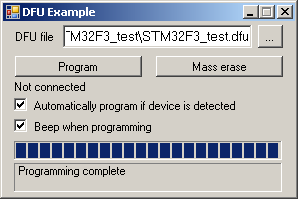
Executable with Visual C# 2008 project/code: DFU Example 20130515.zip
Alternative hardware
Pretty neat idea from Juris Perkons - as STM32F303CBT6 is pin-compatible with STM32F103C8T6, cheap "blue pill"
can be used as a board for STM32F303CBT6 after desoldering STM32F103C8T6:
